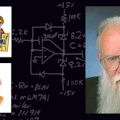This is part six of a six part series.
Recently, I have been riding on various trains—BART in San Francisco, CalTrans trains, various people-movers in airports, plus the London Underground. I've even been on some ferry boats. At one time, claims were made that Fuzzy Logic could help a subway train, such as the Sendai train, use less energy, go faster and smoother, and stop at exactly the right place in less time. Well, I punctured that bogus baloney back in "What's All This Acceleration Stuff, Anyhow?" (Electronic Design, Analog Applications Issue, Nov. 7, 1994, p. 63). I showed that the claims were based on faulty computer simulation. The report claiming all those advantages was published before the trains were running. No updates or corrections were published after the trains were running—until I punctured the myth.
Claims were made that trains could be stopped in exactly the right place, which was not possible with conventional controllers. I have recently seen trains on the London Underground that stopped very smoothly and crisply, with less than an inch of position error. This is because the track-side door had to align with the door of the train, within less than an inch of tolerance. The London trains could stop perfectly and consistently. And these trains were old. FL had not been invented when they started running, so I doubt FL is being used.
Other "people-movers" at airports—little trams such as the ones at Minneapolis, SFO, DFW, and ORD—do seem to stop at the right place, but only by slowing to a crawl and then creeping up the last few inches. This, of course, wastes seconds. BART seems to stop within about two feet of its target. Maybe the "Sendai Train" can do better, but hey, good enough is good enough. I realized that stopping a train from 60 mph (88 ft/s), with precision of 1/12 ft, would require putting on the brakes with millisecond precision. Obviously, no subway train can justify the precision of train location within an inch at 88 ft/s. This would require hitting the brakes at the exact correct millisecond.
Then I realized that every good racecar driver has to hit the brakes, when coming down the straightaway at 120 mph, with millisecond precision. If the driver brakes 0.1 s too late, he will swing about 17 ft too wide at the corner and will be at a serious disadvantage. If he brakes 0.2 s (34 ft) too late, he will overrun the corner badly and risk wrecking his car in the hay bales. If he starts braking 0.1 s too early, he will waste about 0.08 s. So racecar drivers have to be very precise in their time to start braking.
So do ferry pilots. It is very important that a ferry boat not "overshoot" its goal. Claims were made that a Fuzzy Logic controller could dock a ferry without even knowing the variables of the system. "A fully loaded ferry could be docked just as fast as an empty ferry" without anybody telling the FL controller what the mass of the boat was, nor the wind, nor the tide. Sure... In view of the recent ferry accident on Staten Island, we really have to be suspicious about human-controlled systems, as well as computer-controlled systems.
After I published "Fuzzy Logic Stuff (Part IV)" (Electronic Design, Nov. 6, 2000, p. 146), I sent copies to several FL experts. I asked them, "Okay, I have just punctured the myth that FL is always better than conventional control systems. Do you see any place where I am wrong? Is FL really not better than conventional systems, unless conventional systems are misapplied, or artificially crippled?"
I not only got zero arguments from the dozen experts, I never even got any reply from any of them. So if Fuzzy Logic is kaput, maybe that is just as well.
Comments invited!
[email protected] —or:
Mail Stop D2597A, National Semiconductor
P.O. Box 58090, Santa Clara, CA 95052-8090
About the Author

Bob Pease
Bob obtained a BSEE from MIT in 1961 and was a staff scientist at National Semiconductor Corp., Santa Clara, CA, for many years. He was a well known and long time contributing editor to Electronic Design.
We also have a number of PDF eBooks by Bob that members can download from the Electronic Design Members Library.
